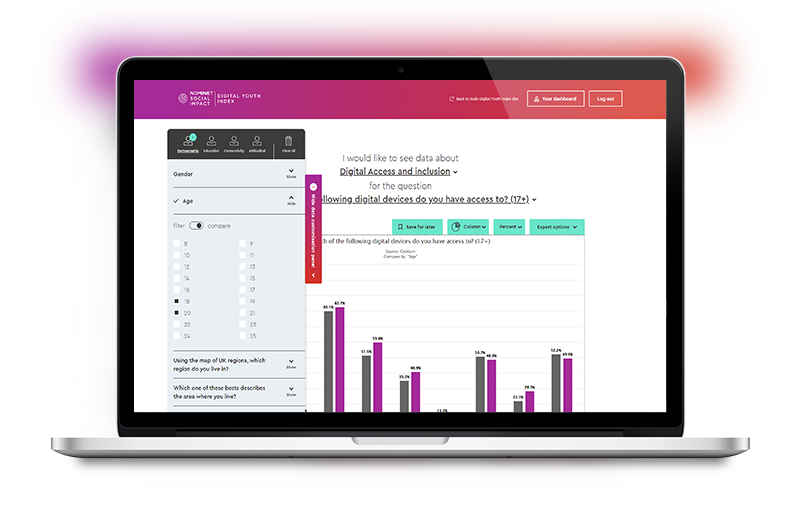Money has always shaped children and young people’s lives – providing opportunities for both agency and exploitation. The internet has amplified traditional opportunities and risks and introduced new factors that are uniquely digital in nature.
Online shopping, open banking, crypto and pseudo currencies, digital assets, gifting and gaming have changed how children learn about finance, given young people more agency and created new ways for them to make, spend and lose money.
The rapidly evolving nature of technologies and the behaviours that they foster presents a challenge for parents, professionals and policymakers to be able to respond in a timely and meaningful way – particularly while respecting children’s rights and need for independence. This is true across all online risks but the challenges presented by financial risks are perhaps less acknowledged.
Prevalence
The Digital Youth Index helpfully provides quantitative and qualitative insights from young people on their experiences and attitudes around online financial risk, exploitation and harm.
35% of young people, including 50% of over-16s, have experienced a scam online. 14% of young people have experienced fraud or identity theft. 20% of those who experienced a scam say they needed help or support to deal with it while 28% of those who experienced fraud or identity theft needed help or support.
These findings are echoed in research by Ofcom that shows scams, fraud and phishing are among the most commonly experienced online risks and harms for both adults and children.
Scope
A significant number of young people are being scammed online, however the scope of financial risk and harm is much broader. Discussions with young people undertaken for the Index highlight a range of financial risk that children and young people experience such as the pressure to spend in games and the confusion that pseudo currencies can create:
“I spend more money on currency in-game than I do on actual new games.” 15-year-old-female
Young people also spoke about digital ‘gifting’ and the potential for exploitation that it may create.
“I was gifted by a stranger once, but it was on Discord. I got given Discord Nitro.” 15-year-old-female
“I gifted a skin once, it was to an online friend. I’ve never met them in person.” 16-year-old-male
“I tried to refund [a game pass gift], but I don’t think you can. You might be able to, but I couldn’t find it” 16-year-old-male
These experiences resonate with other research that shows young people commonly use gift cards to purchase items online.
Support
Throughout the Digital Youth Index, young people refer to the importance of parents in providing information and support. Online finance is similar in that regard. However, whilst parents are often involved, children have greater independence than is perhaps acknowledged:
“I think mostly about learning about financial safety online, it has been through my parents or something, so not mainly in school.” 15-year-old-female
“My parents work so usually they’re tired and I’ve got my old bank account that is not linked to my parents so I could just kind of spend money without them getting the message. So, I think they know some part of the amount I spend.” 16-year-old-male
A problem hiding in plain sight?
Digital Youth Index data supports more detailed research on financial harms conducted by Parent Zone that shows 96% of 13- to 18-year-olds in the UK have made an online purchase and collectively they spend over £53m per week online. Most of that money comes from parents, but parent oversight varies greatly with 88% of those spending £20 or more a week online saying that they have bought something by themselves.
Young people that Parent Zone consulted with spoke of a sense of pride in having financial independence but they also highlighted the ease with which financial harms can occur and they demonstrated a reluctance in seeking help when things go wrong.
“My little brother wanted to buy something on PlayStation and he used my grandad’s credit card and it was a scam and he lost £240.”*
“My brother bought a skin for £20 and never got it. He lost the money. He wasn’t allowed to go on his Xbox for a while after that.”*
“My parents consider me old enough to make decisions.”*
“I wouldn’t feel comfortable telling because I’d probably get embarrassed.”*
Worryingly, Parent Zone found that three-quarters (76%) of 13-18-year-olds believe other people their age are breaking the law online and 5% of the children and young people surveyed had made money through gambling video game items – something that is not legal for children to do in the UK. This suggests that much more is happening than the data we have may show.
System change
The data we do have raises important questions about the nature of online financial risks that young people regularly experience and what is being normalised. It also challenges us to consider how platforms are designed and regulated, the education that is available for young people and how parents might be better supported.
The Child Financial Harms consortium – led by Parent Zone and supported by Nominet through the countering online harms innovation fund – is working to enhance cross-sector understanding of online financial risk and to answer the critical questions about why, where and how we should respond in order to reduce the harms that young people experience online.
Over three years, the consortium is identifying opportunities, testing interventions and sharing learning that will contribute to a system change in how online financial harms are acknowledged, tracked and responded to.
As with all things digital, financial risks and harms do not exist in a vacuum; there are multiple intersections between on and offline experiences, individual and collective vulnerabilities and between other forms of harm and exploitation. Acknowledging online financial harms as a distinct factor whilst understanding how it relates to other aspects of young people’s experiences is critical for affecting change. The Digital Youth Index and the tools available to interrogate the data provide opportunity to explore those intersections.
The inclusion of financial harms in the Index reflects the evolving nature of young people’s lives. Through this and the Child Financial Harms consortium’s work we are given a window into a significant aspect of young people’s experience that can and should inform how we take action.
*Quote from Parent Zone research
Share this article







